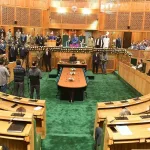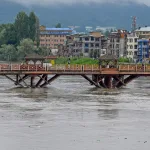SHARING EXPERIENCE
Every region has its own unique features and distinct characteristics. The study of this uniqueness and distinct characteristics of the region helps us to understand the profile of the area, the localsetup, working of the institutions, and the challenges associated, which provides an opportunity to look for various solutions for the target region.
The region in discussion sometimes referred to as the ‘Krihun’ region of North Kashmir locally, is surrounded by mountains from the north and west side and is located amidst the mountains mostly and is drained with various Streams like Ningli, Babul, and Frasthar.The region carries a pristine beauty comprising of plains, hills, and mountains. The region has its old history and the associated rich culture which is evident from the patterns of socio-religious fabric of the society. The famous shrine of Haji Murad Bukhari (RA) is located in the area having its long history.
Kreeri region has a recorded history of around 600 years when the Sufi saint, scholar, mystic, and Authority on Islamic Law Hazrat Mir Syed Haji Murad Bukhari (RA) made it his abode. His ancestors had come from central Asia and traveled to the valley from Multan. During his time Sultan Zainul Abideen, Badshah visited the Kreeri region and offered Friday Prayers under his leadership. His Khanqah and Ziarat are revered by all Muslims of the valley which is remarked by the celebration of Urs every year at the Mazar. The region has a rich cultural diversity and has given birth to intellectuals including poets, and personalities related to performing arts like Rabab, etc. In addition to this, there is a passion among the intellectuals and youth of the area for the study and practice of Journalism.
The area is mostly rural having a mix of hamleted and dispersed settlement patterns and has a demographyin the third stage of transition, comprising of most of the population in the youthful stage. The people are mostly engaged in primary activities of horticultural and agricultural-relatedactivities. A portion of the population is also engaged in the service sector and has established small and medium-scale businesses. The region is famous for its apple orchards throughout Kashmir. The famous brand of Kashmiri apple ‘Ambri’ is also found in the locality. The area is also famous for the freshwater springs that are found in the nearby villages. The water is fresh and mostly sweet in taste. Some of the famous variety out of these springs is the ‘Khudchetar Naag’ and ‘Pathnaar Naag’.
A major source of irrigation like Babul canal having its source at Drung and frasthar nallah are among some of the major sources of irrigation which have been bestowed by nature to the area and have a great role in making the region more fertile and productive. The deficit of irrigation supplies can be fulfilled by renovating some traditional canals like Shah Koul from village Kohlina to Kawcheck which will prove fruitful for the agriculture and horticulturesector as it has the potential to further fill the gap of irrigation needs in the area. In addition, the region is the source for drinking water supply and hosts many water filtrations plants, to mention one located at Salam Deedar provides the drinking water supply not only to the local area but caters and covers the needs of adjoining regions also.
The region got a separate carved-out assembly constituency 12 wagoora-kreeri recently. This not only added to the distinct identity of the region but also became an underlying factor for integrating the region for an effective governance. After setting up of the three-tier system of local government the governance structure in the region at grass root level comprises of panchayats at the village level, a block developmental council,and a member of the district developmental council.
The region has an active and vibrant local government system that is working in tandem with the local administration, with the full active participation of representatives at the grass root level. There is an establishment of two tehsil offices and one block development office in place, in addition to the other public offices for providing basic public services to the people. Having a sub-district hospital and a big market provides all types of amenities to the people of adjoining areas. It is also a police sub-division headed by a sub-divisional police officer, comprising three police stations with 62 villages in its jurisdiction, besides a post office, a degree college, and subdivision-level offices of Horticulture, Animal Husbandry, Irrigation, and water supply departments.
The connectivity of the area is well-planned and it is connected with a network of roads. The unique thing is that all villages are interconnected having multiple options to access. The optimum road length has been achieved mostly and further, there is a scope now to improve its quality.
The alluvial and loamy soils in the region have great potential in terms of the local agricultural, horticultural, and cottage industries as well. The economy in the region is mostly dependent on the Horticulture sector. More and targeted awareness regarding different schemes in the sector and new seeds and technology will play a very important role in giving a further fillip to this sector.There is a potential for fisheries in streams like ningli nalla, frasthar and babul canal which is already being tapped. In addition to this, there is also a potential for hydropower generation at locations like Shranzfall which can be tapped to make the area self-sufficient for its own power supply.
From the tourism point of view, the region has many important potential destinations like shrunz water fall and hosts a number of identified tourist villages where homestay facilities are already in place. There is a huge potential for tourism activities in the area in view of the scenic beauty of the area across its length and breadth, which if tapped properlycan pave the way for boostingof tourism in the region. In this regard, it is mentioned that the most significant road connection from Tapper to Babareshi has great potential for thedevelopment of Road infrastructurewhich will give a boost to the tourism in the area.
On the other hand, the appraisal of the region also indicates that the mountainous and hilly topography at times presents some challenges also in the form of disasters like floods and landslides. This presents some challenges in the implementation of various developmental programs and in smooth public service delivery. One important concern is the sinking of the soil in the Kandi belt of the region which is affecting the shelter, agriculture, and other livelihood activities.
This problem needs a specific solution in terms of long-term planning for the development of infrastructure and planned settlements including rehabilitation. On the other hand, the region is also facing the threats of seasonal flood-like disasters in Nallahs like Ningli which again requires long-term planning for building of infrastructure in and around the command areas and having a planned development in the region. Besides this, the scattered nature of hamlets also presents some challenges, in grass root level governance which definitely can be improved by improving the connectivity.
From the discussions and points made, it can be determined that the physically and culturally rich region in discussion has some specific needs in view of potential for the development of Agriculture and horticulture sectors where interventions have a definite role to play. Capacity building of the local government representatives and staff, and adoption of the regional planning process and techniques, has not only a certain role to play in the growth and development of the region but also in achieving of robust public service delivery system for achievement of the larger goals of good governance.
(The Author is Tehsildar Kreeri-Wagoora. He can be reached on: [email protected])





